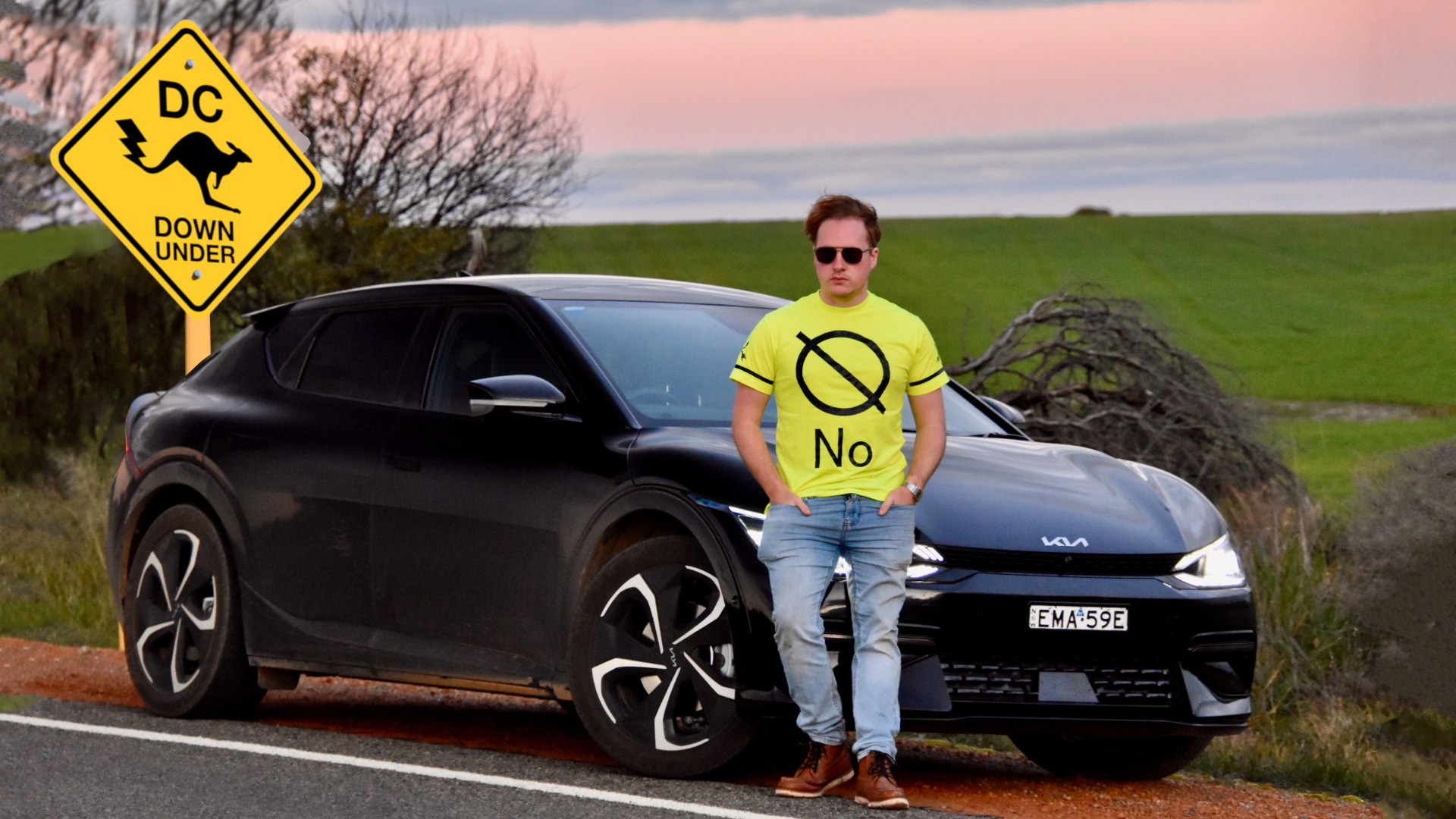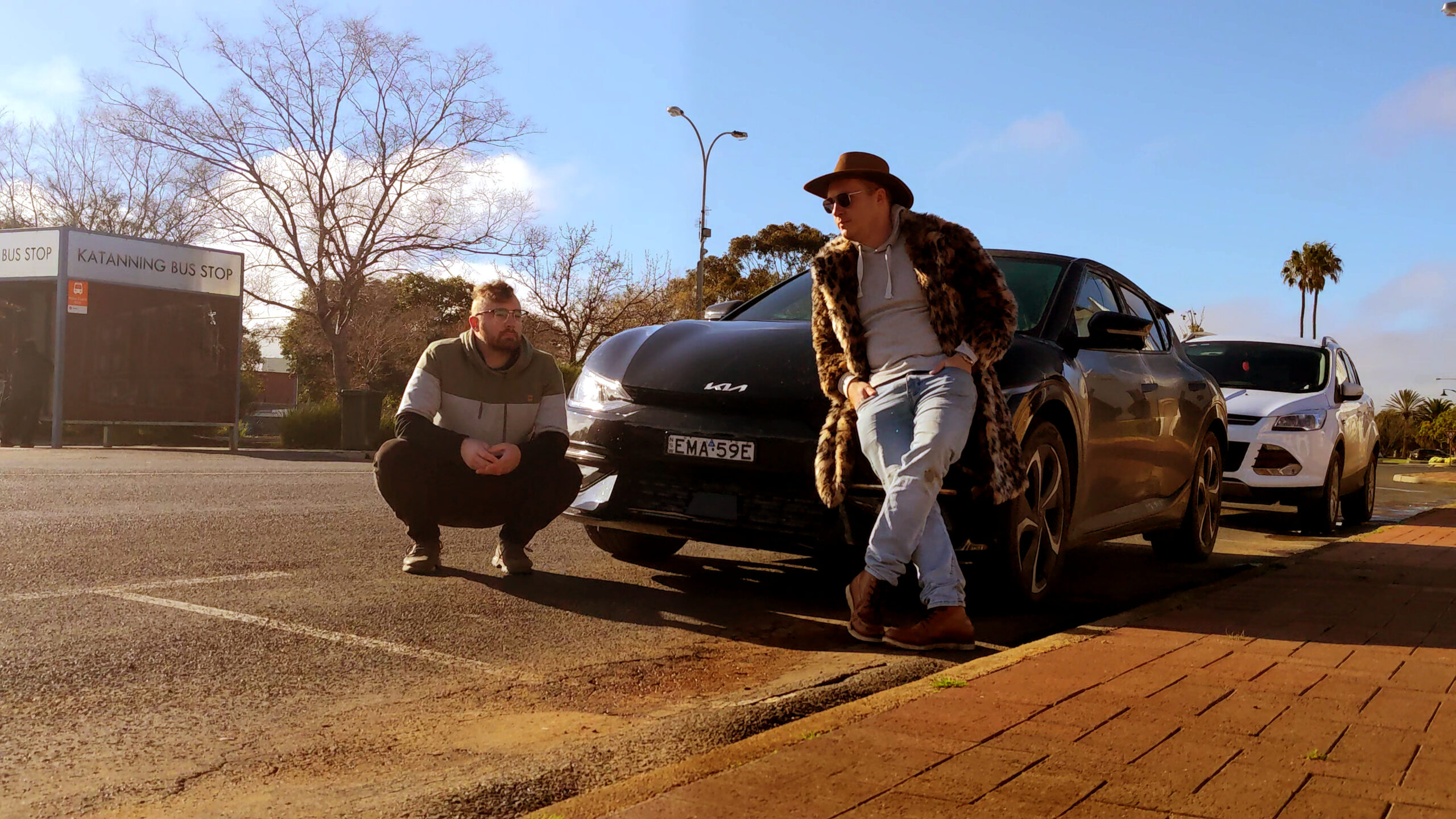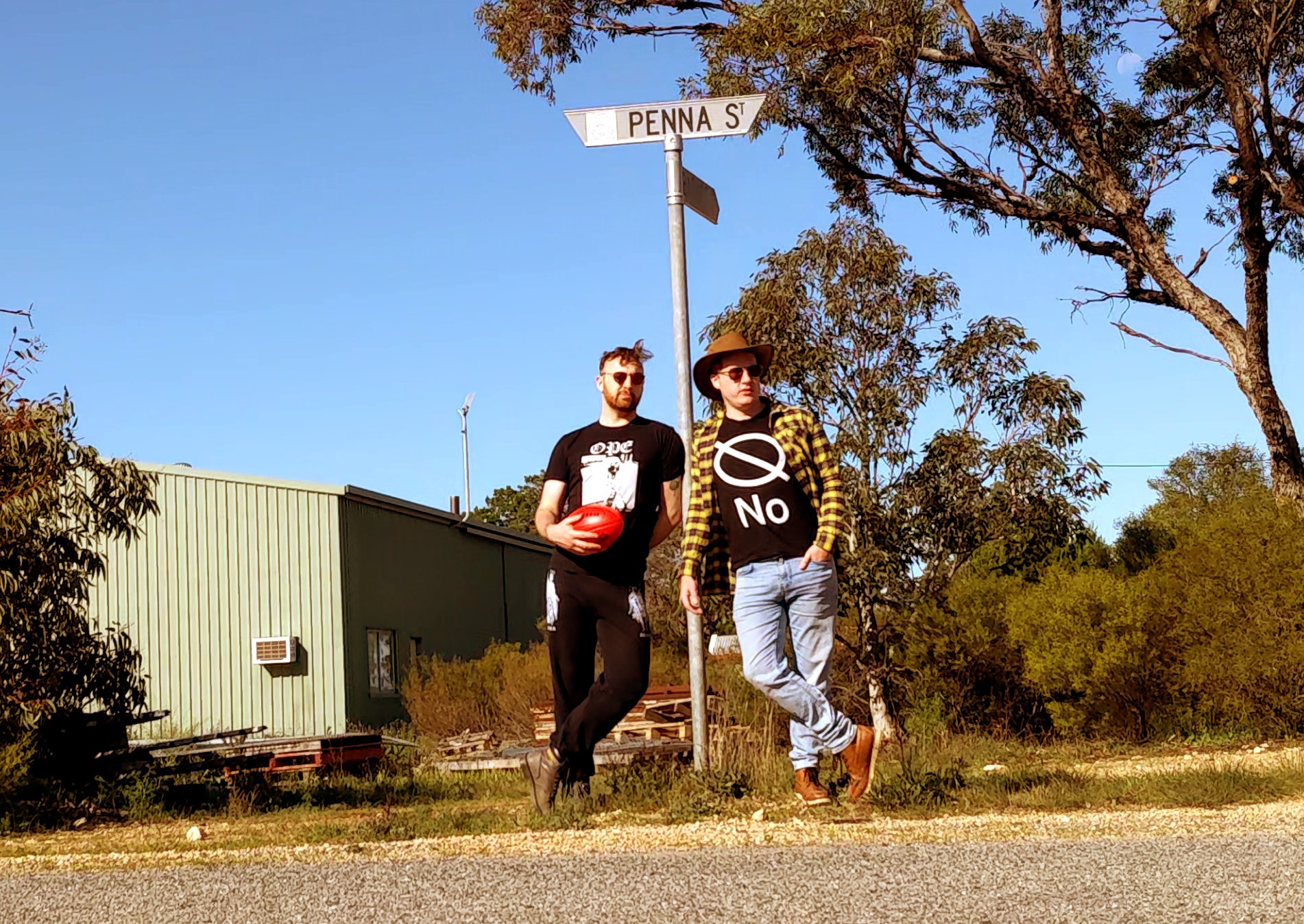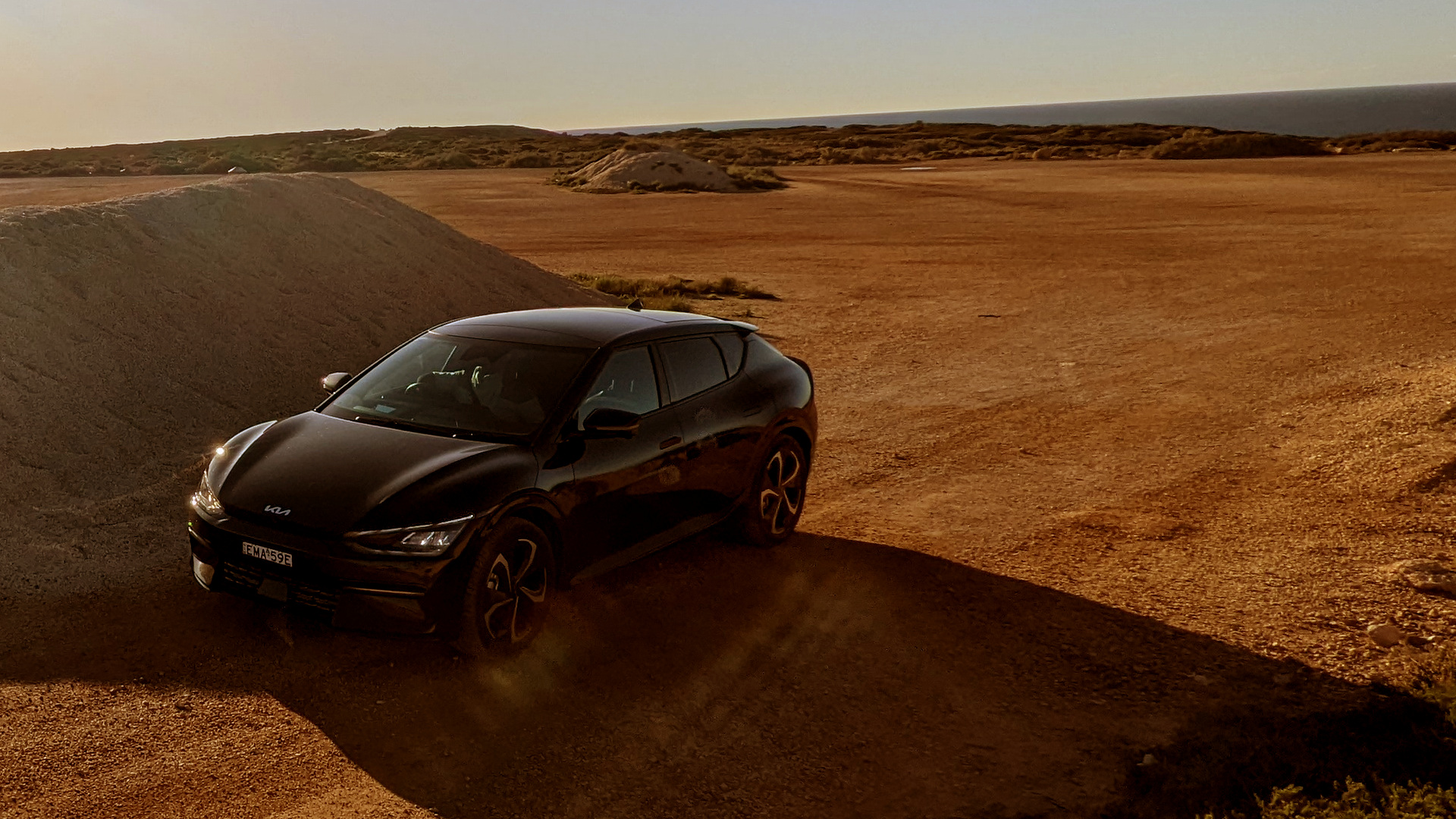

Ding.
They say the first stage of grief is denial. A warning flashed up on the dash, reading “Check brake system.” It was entirely unexpected, given the Kia EV6 hadn’t missed a beat since Adelaide. Surely just a little glitch or mistake. It was hardly going to keep us from finishing our epic journey, after all.
We switched the car off and waited a moment before turning it back on, assuming it was nothing to worry about.
Ding.
So things were going to get a lot more complicated, then…

[Welcome to project DC Down Under, a project in which The Drive sent the indomitable Lewin Day and James Gilboy across 1,700 miles of the Australian Outback over the span of five days in a Kia EV6. Electric cars in 2022 thrive in places where there’s a healthy number of public chargers; doing so across the Nullarbor Plain is another matter altogether. This is the seventh story in the series. You can read parts one, two, three, four, five, and six here.]
A Twist of Fate
Ding.
The second stage of grief is anger. Neither James nor I lashed out, but we were certainly frustrated. The dashboard was indicating a major issue while being painfully vague about what it was.
The cogs began turning in our heads as we tried to figure out what it meant. Searches online turned up nothing. We looked under the hood for clues. The brake fluid was full. A wet spot under the car looked like condensation from the AC. We hadn’t left the parking brake on, either—it was electric, and deactivates automatically when driving away.
At this point, we started bargaining. We could give it a test: a short run down the road, nice and slow. We had regen braking, after all. Maybe we could do an emergency stop to see if the brakes were working properly. Maybe the error would clear. Maybe it would be okay. We went 200 meters without major incident and the brake pedal felt normal. But the message wasn’t clearing. The dash continued blaring while providing no new information.
We couldn’t ignore the problem any further. Perth was still almost 200 miles away, on dark roads and far from any help or assistance.

Pulling the Plug
As an auto journalist, I don’t rock up here to talk about my personal life. What I will say is, at this point, I remembered I had someone really rather special waiting for me at home. It made me realize that I didn’t want to drive a car at 68 mph through pitch-black darkness while it screamed about a brake problem. I really didn’t want to do that for three hours in the middle of nowhere. But most of all, I didn’t want to regret doing it while bleeding out in a ditch somewhere after having suffered potential brake failure.
It would have been a neat ending if we’d thrown caution to the wind and limped on to Perth. But pressing on would potentially have been career suicide, too. If the worst happened, we’d be sunk—the first question we’d be asked (from Kia, from our editors, from authorities) is why the hell were we driving a car flashing a clear brake warning. I realized there was only one choice to make at this point. The EV6 would end its journey here, for our safety as well as everyone else’s.

It was the toughest call I’ve had to make in my career. This project had been my baby for the best part of a year, a lot of people put in a lot of time, energy and money making it happen, and here I was calling it quits so tantalizingly close to the finish line. We’d been making our own little travel epic, and it was undeniably not supposed to end like this. We wanted victory, not fizzling defeat. There was a bitter lump in my throat as I picked up the phone to tell the higher-ups that I was pulling the plug.
Logistically, too, it was a total disaster. Not only would we miss our hotel booking in Perth, but it was now pushing 10 p.m. and the small town of Katanning isn’t exactly bustling with accommodations. The handful around mostly close their front desks before 7.
The fourth stage of grief is depression, and this definitely qualified. It was only intensified by the prospect of spending a cold night sleeping in the front seats of a compact SUV. Thankfully, a last-ditch attempt to call a local bed-and-breakfast paid off. By the skin of our teeth, we each got a bed for the night, thanking our lucky stars for the roof over our heads. With my head on the pillow, I started moving towards acceptance.

Escape From Katanning
We woke early, as we now had to find transportation to Perth for both us and the Kia. Our B&B hosts ran us through the local options and put out feelers in case someone they knew was headed to Perth.
James and I were still full of questions about the Kia. I put in a call to our press contact, and Kia’s technical staff had us run some basic checks. Sadly, leaving the car parked overnight had done nothing to clear the error.

With the nearest dealership over 100 miles away, there was no way to pull codes and nothing more to be done. We suspected something minor, like a dodgy wheel sensor or pulled-out connector, but eventually Kia’s techs came back with a final verdict: Park it.
The EV6 would cross the finish line on the back of a tow truck.
When the flatbed arrived, it brought mixed feelings. On the one hand, it saved us an incredibly impractical journey by bus and by train, as it showed up bearing a Kia Sorento we could drive to Perth. At the same time, as the EV6 was pulled up the ramp, we were giving up the victory we wanted. We’d been robbed of that glorious photo of us and the car, posing by a gaudy sign marking our arrival in Perth.
The final hop to Perth passed quickly, with not a single kangaroo spotted out the window. In the end, James made it a full 1,700 miles across the Outback without seeing a single wallaby, wombat, or kangaroo. I felt for the guy, I really did.
That night, we made it to Perth, checked into our hotel, and closed out the trip with a few glasses raised in honor of our journey. The city has come a long way in the last two decades, and it was a nice way to round out what had been an incredibly eye-opening trip.
What We Learned
Electric vehicle detractors suggested we wouldn’t make it, stating an EV simply couldn’t get across the Nullarbor, at least with anything resembling an acceptable pace. Fundamentally, we proved that wrong, as have the many other EVs that have done so before us. The EV6 made it across the Nullarbor without incident. Instead, the problem that stopped our journey seemed to be unrelated to the drivetrain, battery, and public charging infrastructure entirely, and happened well past the Plain. Kia has yet to report back on what the actual issue was, but we’re eager to hear what happened.
With that said, the entire trip was still, by no means, a simple task. Assuming you don’t want to spend 20 hours charging your car off a regular plug socket in a caravan park (and I promise you, you don’t), doing this trip requires a lot of planning.

I spent hours working up our route and initially calculated we could comfortably make the journey in just four days. I then spent more hours reworking the route to fit in a new charging stop. Why? All because one town wound up not having any lodgings available, and we were relying on it to juice up overnight.
If just one charger is out of action, you need to check if you have enough range to make it to the next town. If not, you’ll have to charge somewhere sooner. If the next town you arrive at only has 10A or 15A outlets, then you’re stuck there for a day.
Alternatively, you might plan to be in town by 5 p.m., but headwinds end up slowing you down. Roll into some of these towns too late, and you’ll find the local contact is in bed and you won’t be able to gain access to the three-phase port you need to charge. If you didn’t call ahead, you might not get into your motel, either.
The worst-case scenario, though, is that you set out on your journey at the same time as another EV driver going in the same direction. Most of the places we stopped had just one outlet or CCS cable. You could easily get stuck waiting hours for someone else to charge before you can hook up, and that then has a domino effect on the rest of your trip, particularly to any accommodation you may have booked.
The truth is that while it is indeed possible, an EV journey across a place like the Nullarbor will remain difficult until there’s a network of DC fast chargers every 100 miles or so. They need to be well-maintained, high-powered, and open 24/7. This would eliminate a lot of the competing factors that make planning such a journey so difficult.
Such a network is difficult to justify right now. There’s little traffic across the Nullarbor, and a vanishingly small amount of it is made up of EVs. It’s difficult to see tiny outposts investing big money in generators that can drive a 50-kW charger to feed the handful of enthusiasts passing through.
So far, donations from enthusiasts have funded new chargers, including ones at Caiguna and Ravensthorpe, and those definitely made our journey much nicer. Government funding will help fill in the gaps in future, but it’s a ways off yet.
After the painstaking process of planning ahead was over and done with, our journey was straightforward. Yes, weather conditions meant we had to slow down to maintain range. Yes, there were some long days. Despite this, if it wasn’t for our surprise brake issue, we’d have made it to Perth only six hours later than I originally intended. Across the whole 1,700-mile journey, only one charger was out of action.

We set out to prove that crossing one of the most desolate and barren places on the planet is possible in an EV. It was impractical, messy, and draining. If that’s the adventure you’re looking for, have at it! But we did it, and the fact that we could at all in 2022 is incredible. I can also promise it was 10 times more interesting than if we’d simply fueled up on diesel and made the trip in two days flat. It also bears noting that such a journey is only remotely feasible thanks to the efforts of EV supporters along the Plain. Without them, it would be impossible.
The journey taught us what it really takes to go long and far in an EV, well beyond the city. It takes organization, the right equipment, and a keen eye on the weather. You need to be running mental arithmetic on the regular, and you need to be flexible enough to change your plans on the fly.
We did all that, and got the EV6 across the desert just like we planned. We might have technically failed to get it the last 177 miles to Perth, but it’s kind of beside the point. We achieved everything we set out to do as far as EVs and the Nullarbor are concerned.
Give it another decade and new EVs and fast chargers will take all the sport out of it. But as for the here and now? Go and have a crack while the going’s still tough. Feel free to drop me a line and let me know how you went.
Beginning | Previous chapter | Next chapter
Got a tip? Let the author know: lewin@thedrive.com